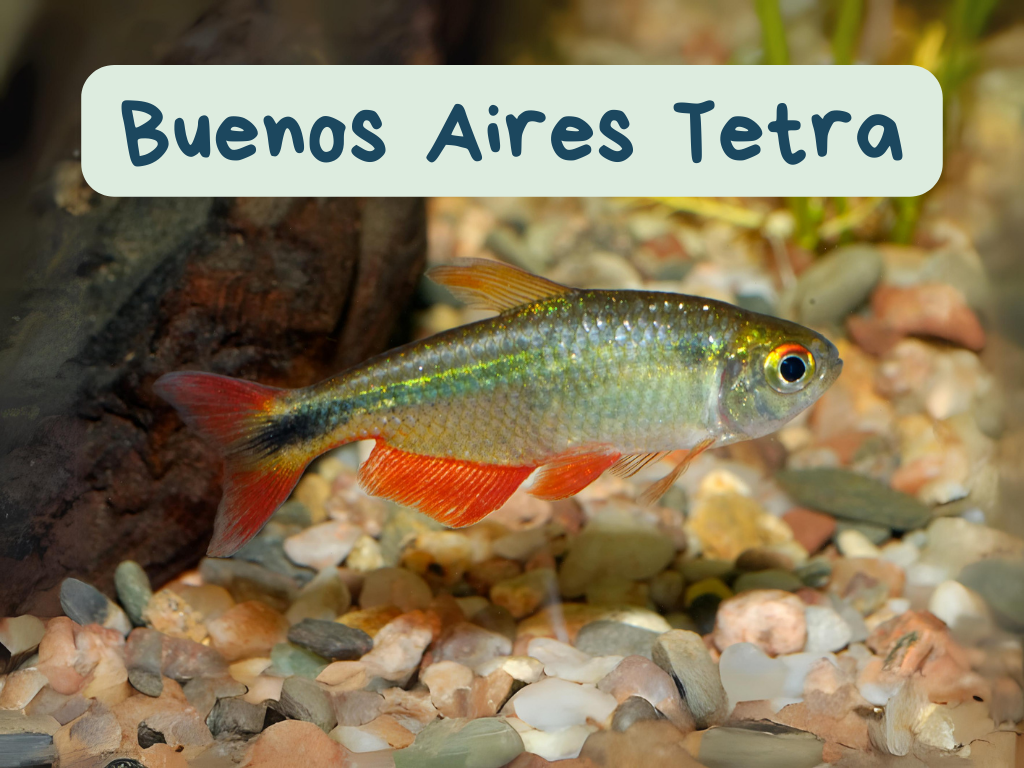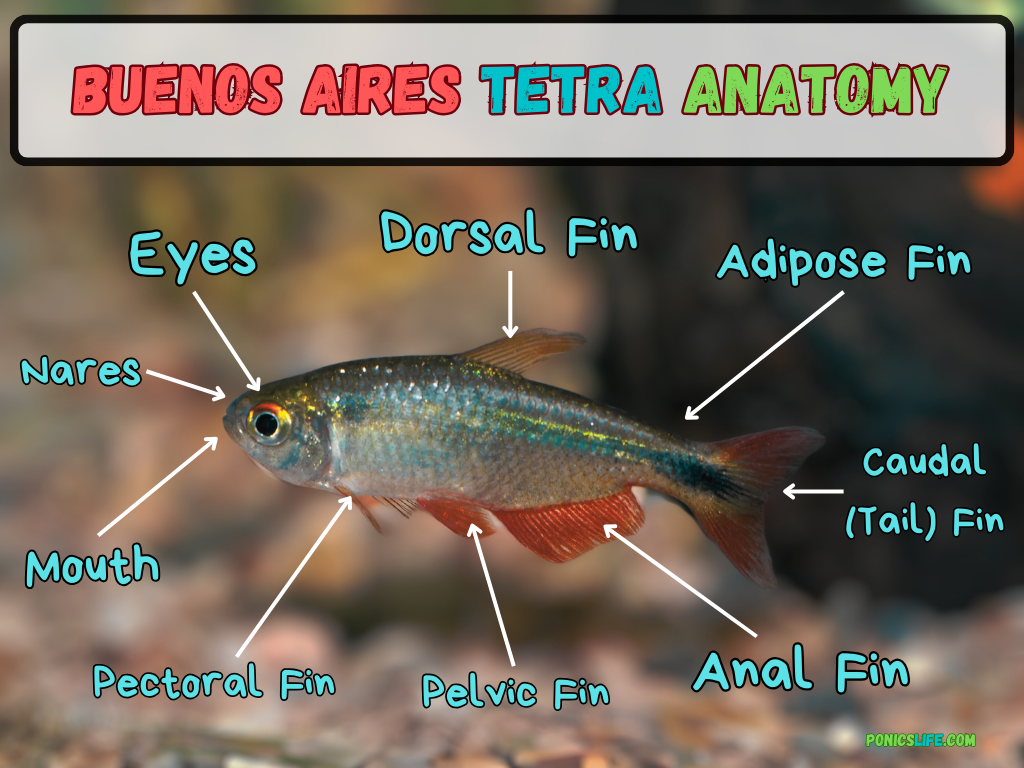Description: The Buenos Aires Tetra (Psalidodon anisitsi) is a captivating freshwater fish, identifiable by its silvery body accented with neon highlights and distinctive black marking on the caudal peduncle. These tetras can reach up to 7 cm (around 3 inches) in length, showcasing red hues on their anal, pelvic, and tail fins. Originating from the La Plata region of South America, they inhabit Argentina, Paraguay, and southeastern Brazil.
Temperament: Buenos Aires Tetras are known for their relatively peaceful nature but may exhibit fin-nipping behavior if not adequately fed or if kept in insufficient numbers. They thrive in groups, displaying a more subdued demeanor and enhanced colors when in the presence of their own kind. This species is somewhat boisterous and forms loose hierarchies, with males often engaging in displays for female attention and group positioning.
Important Note: The scientific name of the Buenos Aires Tetra Fish was changed from Hemigrammus anisitsi to Psalidodon anisitsi. This change reflects the correct scientific name that was determined more recently, even though to most aquarists, the species might still be known as Hyphessobrycon anisitsi.

Identification
Buenos Aires Tetra
Common Name: Buenos Aires Tetra
Other Names: Red Cross Fish, Diamond Spot Characin
Scientific Name: Psalidodon anisitsi
Order: Characiformes
Family: Characidae
Genus: Psalidodon
Species Facts
Buenos Aires Tetra
Temperament: Generally Peaceful
Max Size: 2.8 inches (7 cm)
Fish Origin: Brazil, Paraguay, Argentina
Diet: Omnivore
Reproduction: Egg Scatterer
Max Lifespan: Around 10 Years
Tank Care
Buenos Aires Tetra
Environment: Freshwater
pH: 5.5 – 8.5
Hardness: 18 – 357 ppm
Temperature: 61° – 82° F (16° – 28° C)
Minimum Tank Size: 30 gallons for 6 fish
Recommended # in group: at least 6
Care and Habitat
Buenos Aires Tetra Care: For optimal care, Buenos Aires Tetras should be housed in an aquarium of at least 30 gallons, as they appreciate space to swim freely. They prefer well-structured, ideally planted setups with moderate water movement, thriving in water temperatures between 61° – 82° F (16° – 28° C) and a pH range of 5.5 – 8.5. Regular meals of small live and frozen foods, alongside high-quality dried flakes and granules, will keep them in vibrant health. It is crucial to maintain a clean and stable aquatic environment, as they are sensitive to drastic changes in water conditions. Groups of at least 8-10 are recommended (6 at a minimum) to minimize fin-nipping behavior and promote natural social dynamics.
Difficulty: Buenos Aires Tetras are suitable for beginners, thanks to their hardiness and straightforward care requirements. They adapt well to a variety of water conditions, making them a forgiving choice for novice aquarists.
Swim Level: These tetras primarily occupy the middle to top layers of the aquarium, displaying their most active and vibrant behaviors when given ample space to swim. Their agile swimming style and schooling nature make them a lively addition to any tank.
Tankmates: Due to their tendency to nip fins, Buenos Aires Tetras are best paired with similarly sized, robust fish that inhabit different tank regions or share similar activity levels. Potential companions include characids, callichthyid, loricariid and doradid catfishes. They may not be suitable companions for very shy, slow-moving, or long-finned species.
Buenos Aires Tetra Diet: Buenos Aires Tetras are omnivorous, feeding on worms, insects, zooplankton, plant material, and organic detritus in their natural habitat. In captivity, they thrive on a varied diet that includes live, frozen, and dry foods, with a preference for small meals like bloodworms, Daphnia, and Artemia. Regular feeding of high-quality food enhances their condition and coloration.
Male vs Female: Sexually mature males are more intensely colored, slimmer, and slightly smaller than females. Females display a fuller-bodied appearance, especially noticeable in their rounded stomach region. These differences in color intensity and body shape make it relatively easy to distinguish between the sexes.
Natural Habitat: Buenos Aires Tetras originate from diverse aquatic environments across the La Plata region, including slow-moving ponds, lakes, streams, and major rivers like the Uruguay and Parana. They prefer subtropical regions with abundant rainfall, mild winters, and are commonly found in smaller streams, floodplain lakes, backwaters, and oxbows.

IUCN Red List Status: The Buenos Aires Tetra is categorized as Least Concern (LC) by the International Union for Conservation of Nature (IUCN), which means that it does not currently qualify as Critically Endangered, Endangered, Vulnerable, or Near Threatened.
Reproduction: Reproduction in Buenos Aires Tetras involves egg scattering with no parental care, making them suitable for aquarists looking to breed fish for the first time. A dimly lit breeding tank with ample plant coverage or spawning mops encourages females to deposit eggs, which typically hatch within 24-36 hours. It is vital to remove the adult fish after spawning to protect the eggs from being eaten. The fry become free-swimming within a few days and should be fed small, suitable foods like Paramecium initially.

Aquaponic Considerations
Aquaponics is a sustainable farming method that combines aquaculture (raising fish) and hydroponics (growing plants in water) in a symbiotic environment. To learn more, explore our Aquaponics Information and Hobby Center.
| Can be used for Aquaponics | Yes |
| Indoor or Outdoor | Indoor Aquarium |
| Ornamental or Edible | Ornamental |
| Stocking Density | 6 fish per 30 gallons |
FAQs
Where did this information come from?
The primary resources used for this article include the IUCN Red List of Threatened Species, FishBase, and other aquarium databases.
How often should I feed my fish?
Aquarium fish generally require feeding once or twice a day. It’s important to provide only as much food as they can consume within a few minutes to prevent overfeeding and potential water quality issues. Adjust the feeding schedule and quantity based on the fish’s activity level and the water temperature, as their metabolism slows down in cooler conditions.
How do I choose compatible tankmates for my aquarium?
When selecting tankmates, consider the temperament, size, and dietary needs of the fish. Peaceful species that grow to similar sizes and have comparable dietary requirements usually make good companions. Avoid pairing aggressive or fin-nipping species with slow-moving or long-finned fish. Researching each species’ behavior and needs is key to creating a harmonious aquarium.
What is the ideal number of fish for my aquarium?
The “one inch of fish per gallon” rule is a common guideline, but it oversimplifies the complexity of maintaining a healthy aquarium. Factors such as the species’ adult size, behavior, and the tank’s filtration capacity are crucial. Start with a conservative number of fish and increase gradually, ensuring the aquarium’s biological filter can handle the waste load.
What should I do if my fish show signs of stress or illness?
First, check your water quality parameters (temperature, pH, etc.) and make sure they’re within the ideal range for your fish. Stress and illness often stem from poor water quality or incorrect temperatures. Isolate sick fish if possible, research their symptoms to identify the issue, and treat accordingly with medication or by adjusting the water conditions. You can read more about fish stress here.
How important is lighting in an aquarium?
Proper lighting is essential for simulating natural daylight cycles, which help regulate fish behavior and physiological functions. It’s also critical for the growth of live plants, which rely on light for photosynthesis. Use aquarium-specific lights and set them on a timer to provide your fish and plants with a consistent light-dark cycle.
Can plants and decorations affect my fish?
Yes, live plants can greatly benefit an aquarium by providing oxygen, hiding places, and natural boundaries that help reduce stress in fish. Decorations should be chosen with care to avoid sharp edges that could injure fish. Ensure all items are safe for aquarium use to avoid contaminating the water.






